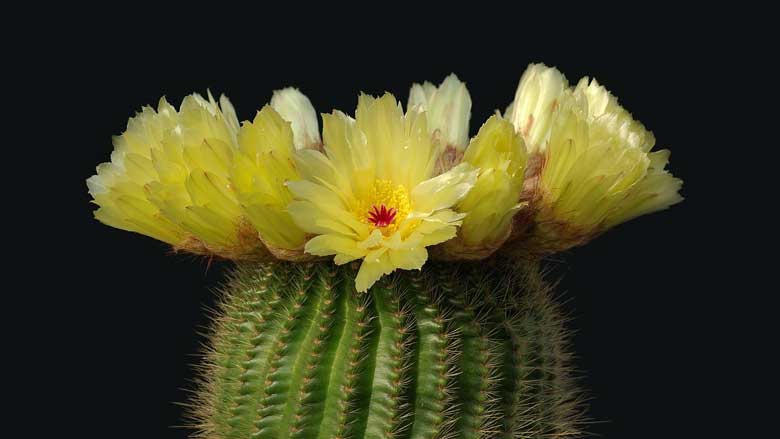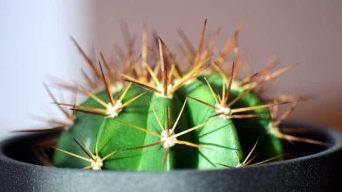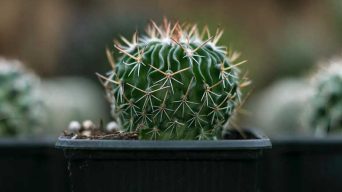Cacti typically bloom annually, but this varies by species—some flower multiple times a season or only after reaching maturity, which can take years. Blooms usually occur in spring or summer, except for night or winter bloomers. Factors like temperature, light, water, and soil affect blooming.
Cacti, known for their easy cultivation and striking appearance, feature spiny, fleshy stems and a range of blooms, from simple to intricately delicate.
Their flowers often exhibit a variety of shapes and sizes, adding to their unique charm.
These flowering plants are distinct within the larger botanical family, boasting unique adaptations to arid environments.
A common question among enthusiasts is the frequency of their blooming.
While exceptions exist, most cacti bloom annually, influenced by factors like the plant’s age and care.
The blooming frequency of cacti varies. Many don’t flower until maturity, which could take several years.
While most species bloom once yearly, some can flower multiple times within a season or every few weeks, a phenomenon known as repeat blooming.
This process continues until halted by extreme conditions.
Several key factors affect cactus flowering:
- Temperature: Cacti often bloom more in warmer conditions, explaining their success in indoor and greenhouse environments.
- Light Exposure: These plants need ample sunlight to flower well. Insufficient light leads to weaker plants and reduced blooming.
- Watering: Both under and overwatering can impede flowering. Proper hydration is essential for consistent and quality blooms.
- Soil Type: Soil drainage impacts root oxygenation. Poorly oxygenated roots can lead to decreased flowering.
Understanding Cactus Flowering Cycles
A cactus flower blooms once a year. Some species produce more than one bloom yearly, whereas others only have one chance to blossom each year.
Cactus flowers can blossom at any time of the year. However, they generally flower during spring and summer when there is much more sunlight.
However, some cacti bloom at night or during the winter months.
Spring Bloomers
Most cacti flower in the spring. The blooming period lasts several weeks, depending on the cactus species.
A flower stem may have one to three flowers.
Flowering occurs only after the plant has matured and is stimulated by longer days with warm sunlight.
Some cactus species that bloom in spring are:
- Schlumbergera gaertneri (Easter Cactus)
- Echinocereus coccineus (Scarlet Hedgehog Cactus)
- Tephrocactus articulatus
- Opuntia basilaris (Beavertail Cactus)
- Opuntia humifusa (Eastern Prickly Pear)
Summer Bloomers
Summer is an active period for cacti. Some cactus blooms are very showy, while others are barely noticeable.
Flowers usually open in the late morning and remain on the plant until they wilt or fall off naturally at nightfall.
A flower may have one to five flowers per stem, depending on the cacti species.
Some cactus species that bloom in summer are:
- Coryphantha macromeris (Nipple Beehive Cactus)
- Echinopsis oxygona
- Thelocactus setispinus (Miniature Barrel Cactus)
- Coryphantha ramillosa (Bunched Cory Cactus)
- Aztekium ritteri (Peyotillo)
Winter Bloomers
Cacti that flower during winter usually produce buds between November and January.
The flowers of a winter flowering cactus appear in the late afternoon or evening on short stems from within special leaf-like bracts.
These emerge at the growing points where leaves have been produced during spring and summer.
The most common winter-blooming cactus is the Christmas cactus, native to Brazil.
This cactus will produce beautiful pink flowers around Christmas time. It is commonly used as a houseplant and will flower around two weeks after being cut.
Night Bloomers
There are many night-blooming cacti, but they all have one thing in common: their flowers only open at night.
The main reason is that the flowers only open at night when it’s’ cool, and they close in the morning as soon as it gets warm.
This helps protect them from damage by intense sun rays during daylight hours.
Some cacti that bloom at night are:
- Epiphyllum oxypetalum (Dutchman’s Pipe Cactus)
- Disocactus anguliger (Fishbone Cactus)
- Selenicereus costaricensis (Costa Rican Pitahaya)
- Selenicereus grandiflorus (Queen of the Night)
- Cereus hexagonus (Lady of the Night Cactus)
How Long Does It Take for Cacti to Flower?
Cacti flowering times vary by species. While some cacti bloom within one to three years, others may take over thirty years.
If your cactus hasn’t flowered within five years, there’s no cause for concern.
Many cacti species naturally take several years to produce their first flowers.
Cacti are renowned for their striking blooms, often a primary reason for their cultivation.
However, it’s common for cacti not to flower in the early years of growth. Patience is key with these unique plants.
Rest assured, most cacti will eventually blossom, so don’t lose hope if your cactus takes longer than expected to flower.
How Long Does It Take for a Cactus Flower to Bloom?
On average, a cactus flower takes ten to twelve weeks to bloom, starting when the bud first appears.
This timeframe is estimated; most cacti produce their initial buds in about six weeks, followed by more buds every few months.
The blooming period, however, can vary. Some cactus flowers bloom in as little as eight weeks, while others might take several months.
Factors Influencing Cactus Flowering
Cacti, especially those native to desert regions, require specific conditions to bloom and produce seeds.
These hardy plants thrive in well-draining soil and need ample sunlight. Without these, don’t expect your cactus to flower.
For indoor plants, ensure they receive enough light naturally through a window or via artificial lighting, which can promote blooming.
Here are additional factors that impact when cacti bloom:
- Cactus Variety: Different types have varying blooming speeds. Research your cactus variety to estimate its flowering time.
- Plant Age: Young cacti may take a few years to bloom, whereas older ones are more likely to have flowered already.
- Growing Environment: Cacti in warmer climates often flower sooner than cooler ones.
Do All Cacti Bloom?
All cacti can bloom. Some bloom only once in their lifetime, while others are known to flower twice or more throughout the year.
Although all cacti bloom, the bloom is not always noticeable. The flower may be tiny or hidden behind leaves and spines, even lacking petals.
Also, remember that some flowers only last one day, while others can live for two weeks.
If a cactus isn’t flowering, it doesn’t necessarily mean something is wrong with the plant.
Some cacti won’t bloom for several years after being transplanted, especially if the cactus was recently moved from a greenhouse or conservatory.
Cacti in containers may not often flower because most blooms occur when plants are actively growing in warm weather and have adequate root space to expand.
Containers can’t accommodate this growth, so they don’t produce abundant flowers frequently.
Recognizing Signs of an Imminent Cactus Bloom
One way to determine if your cactus will flower shortly is by its color.
If you notice that it becomes more greenish, the chances are good that a bud has started growing on top of it and will soon open up into a gorgeous flower.
Of course, there are exceptions to this rule. Some types have white or yellow flowers, which do not indicate that the cactus is about to flower.
In most cases, you will notice a pretty change of color when it comes time for your cactus to bloom again.
Duration of Cactus Flowers
Cactus flowers will only last a few days to two weeks.
Some may even close up after just one day if they are pollinated or fall off on their own accord before this has happened.
Most cactus blooms open in the early morning and fade by noon, but some varieties of cacti can stay open all day long as long as they receive enough sunlight.
The flowers of some varieties can last up to two weeks, but most will be gone within a few days at the very most.
If they are pollinated, some varieties of cacti will stay open all week.
What to Do After Your Cactus Blooms?
Minimal intervention is key to maintaining a healthy cactus after blooming. Simply let the plant be.
After the flowers have fully faded, then you can consider further steps.
Remember, if executed properly, certain actions might extend their lifespan, as with any plant’s life cycle.
1. Watering
Don’t water your cactus plant until the soil is completely dry.
They do not need their soil to be wet, and overwatering can lead to root rot or mold growth, which will most likely kill off a healthy succulent in no time at all.
2. Light
Once your cactus flower has bloomed, ensure it gets a lot of light.
Don’t place them in direct sunlight for hours on end because this can lead to sunburns, and it will kill off any new growth that may have been developing.
Just enough bright light is needed to keep the plant healthy and growing.
3. Temperature
If your cactus is placed in a room with cold drafts, it will not perform as well, and its growth may be stunted.
The ideal temperature for most cacti is between 20°C – 25°C (68°F – 77°F).
This way, they can grow to their full potential and bloom when ready.
4. Soil
Keeping your cactus healthy must be done in soil that drains well.
Soil that retains water can lead to root rot and mold growth quickly, so be sure the plant has enough drainage holes for the excess water.
5. Pests & Diseases
Cacti may not have many pests that are specifically harmful to them, but they can still get common houseplant pests like spider mites and mealybugs.
These bugs feed on the plant’s juices and will do much damage if left untreated.
If you notice these insects crawling around your cactus, take care of it immediately before things get out of hand.
Another potential threat is mold growth, particularly if the plant’s soil has excess water, which cannot drain properly.
If you see any fungus growing on your succulent leaves or stem, it must be removed immediately to prevent spreading and killing off the plant entirely.
Tips for Encouraging Cacti to Bloom Again
Cacti bloom can be pretty impressive, especially if you have never seen one.
It is essential to know that the plant will not bloom again for several years once its blooms are finished, and they usually only do so every year or two, depending on the species.
You must mimic what it would do in the wild to get a cactus to flower again.
1. Optimal Watering
It is important that after cactus bloom, it dries out completely before being watered again.
If you water too quickly or are kept overly moist during this time, they can be susceptible to root fungi and other diseases.
When a cactus is waiting to flower again, keep it very dry and only water them enough so they don’t shrivel completely.
2. Sunlight
Avoid giving your cactus excessive water or exposing them to too much sunlight, which can decelerate their blooming cycle.
They need to be given enough sun to grow, but not too much that it causes them to stop blooming.
This is a delicate balance; you should research your specific species to determine how much sunlight they need.
3. Soil Conditions
You should also ensure that you are giving your cactus the right soil. They need to drain properly so they don’t get root rot and other issues.
A mixture of 50% potting soil, 25% sand or perlite, and 25% composted manure is a good idea for most species of cacti as long as you mix it all before putting it into the pot.
Finally, remember that most cacti are succulents and do not need extra water or sunlight during their resting period.
You should only give them the right soil mixture and keep them dry until they flower again.
If you want your succulent to bloom more often than this, it is best not to wait for it to flower and instead begin a new cycle by sharing some of the tips above.
Comparing Cactus Flowers with Other Flowering Plants
Cactus have adapted to survive in hot and dry conditions where other plants cannot.
Their petals often close up during the day and do not expand until late evening when the temperature lowers and the sun is no longer as harsh.
Flowers are often pollinated by bats, moths, or night-flying insects that can navigate during this period.
This allows them to avoid heat and direct sunlight, which would otherwise harm their delicate bodies if they were active in the day like other plants’ flowers tend to be.
Final Thoughts
Cacti, a popular choice among houseplants, are easy to care for.
They require little water, sunlight, and attention, so you can leave them on the window sill for days without worrying about killing them.
Cacti flower at various times throughout their life, but they generally bloom once a year in late spring and early summer when the day is long enough to produce flowers.
This flowering season brings out their unique beauty, showcasing a range of colors and forms.
Cacti that flower in the summertime will have a much longer bloom period than those flowering in early spring or late fall since blooming depends on day length, and cacti may only store enough energy for one short burst of activity during their lifetime.







